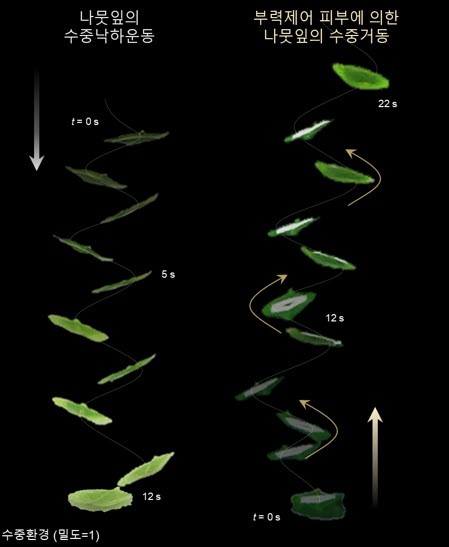Research News
[Prof. Kyu-jin Cho] 'A carpet that flies' in the water? Development of Underwater Soft Robots that Simulate Leaf Movement
- Presenting new concepts applicable to solving marine environmental problems such as oil spills

▲ Schematic diagram of the swimming leaf robot inspired by the fluttering falling motion of leaves.

▲ (Left to right in the first row) Professor Cho Kyujin from Seoul National University's Department of Mechanical Engineering, Dr. Byun Junghwan from the Max Planck Institute (former researcher), Seoul National University researchers Park Minjo, Baek Sangmin, Kim Woongbae, (Left to right in the second row) Professor Hong Yongtaek from Seoul National University's Department of Electrical and Computer Engineering, researcher Yoon Jaeyoung, and Dr. Lee Byungmoon
Seoul National University's College of Engineering (Dean Cha Kukheon) announced on the 22nd that a joint research team led by Professor Kyu-jin Cho (Director of the Human-Centered Soft Robot Technology Research Center) of the Department of Mechanical Engineering has developed paper-thin underwater soft robot technology.
The research team developed a technology to control density distribution in the form of thin skin and succeeded in creating a new underwater behavior form with a paper-thin structure. This achievement was recognized as a study presenting new forms and functionalities of underwater soft robots, and was published in "Science Robotics," a world-renowned journal, on April 21st.
The team drew inspiration from the everyday phenomenon easily observed by anyone: the fluttering and falling motion of leaves in the air. Lightweight and thin objects such as leaves or paper create various movements without any special propulsion due to air resistance.
The researchers found that the movement heavily relies on the density distribution of the object and is significantly enhanced in underwater environments. Furthermore, by patterning highly responsive composite materials that change density significantly in response to heat like skin, the team succeeded in actively controlling the density distribution of the entire system. This density distribution control technology enabled thin, arbitrary structures like paper to perform underwater movements resembling the fluttering of leaves without significant deformation of the body or propulsion devices like propellers.
This technology can be used widely, from sizes as small as millimeters to large areas of several meters or more, and has the potential to integrate various functions required for exploration and maintenance of marine environment. To demonstrate these possibilities, the researchers presented a concept where a small-scale water tank equipped with oil-absorbing sheets autonomously swims to reach oil spill areas and remove pollutants. Although it has not yet been equipped with batteries and electronic circuits and requires further research on motion control in flowing water, developing the current conceptual research is expected to demonstrate new possibilities for underwater soft robots.
Professor Cho Kyujin, the head of the research, stated " his study is the first to show the concept that a thin soft robot can perform a new type of behavior similar to the movement of a leaf underwater. If we further develop this concept, we can develop new forms of underwater soft robots capable of removing marine pollution such as oil spills and garbage." This research was supported by the Leading Research Center Program and the Basic Research Program for fostering academic successors of the Korea Research Foundation.
[Reference]
- Figure Description

▲ a. Diagram of the buoyancy control technology developed by the research team and a swimming leaf robot inspired by it. b. Buoyancy control principle. A structure is created by inserting a low boiling point gas into an elastomer (a polymer compound highly susceptible to external forces), which reacts to heat to produce a significant change in volume, thereby controlling buoyancy.

▲ Underwater behavior of the leaf robot inspired by fluttering falling motion of leaves.
- Check the YouTube video:
- Title and Authors of the Paper
- Authors: Professor Cho Kyujin (corresponding author, Seoul National University), Dr. Byun Junghwan (first author, Seoul National University, Max Planck Institute, Germany), Park Minjo (Seoul National University), Baek Sangmin (Seoul National University), Yoon Jaeyoung (Seoul National University), Kim Woongbae (Seoul National University), Dr. Lee Byungmoon (Seoul National University), Professor Hong Yongtaek (Seoul National University)
[Inquiries]
Professor Cho Kyujin, Department of Mechanical Engineering, College of Engineering, Seoul National University / 02-880-1679 / kjcho@snu.ac.kr

